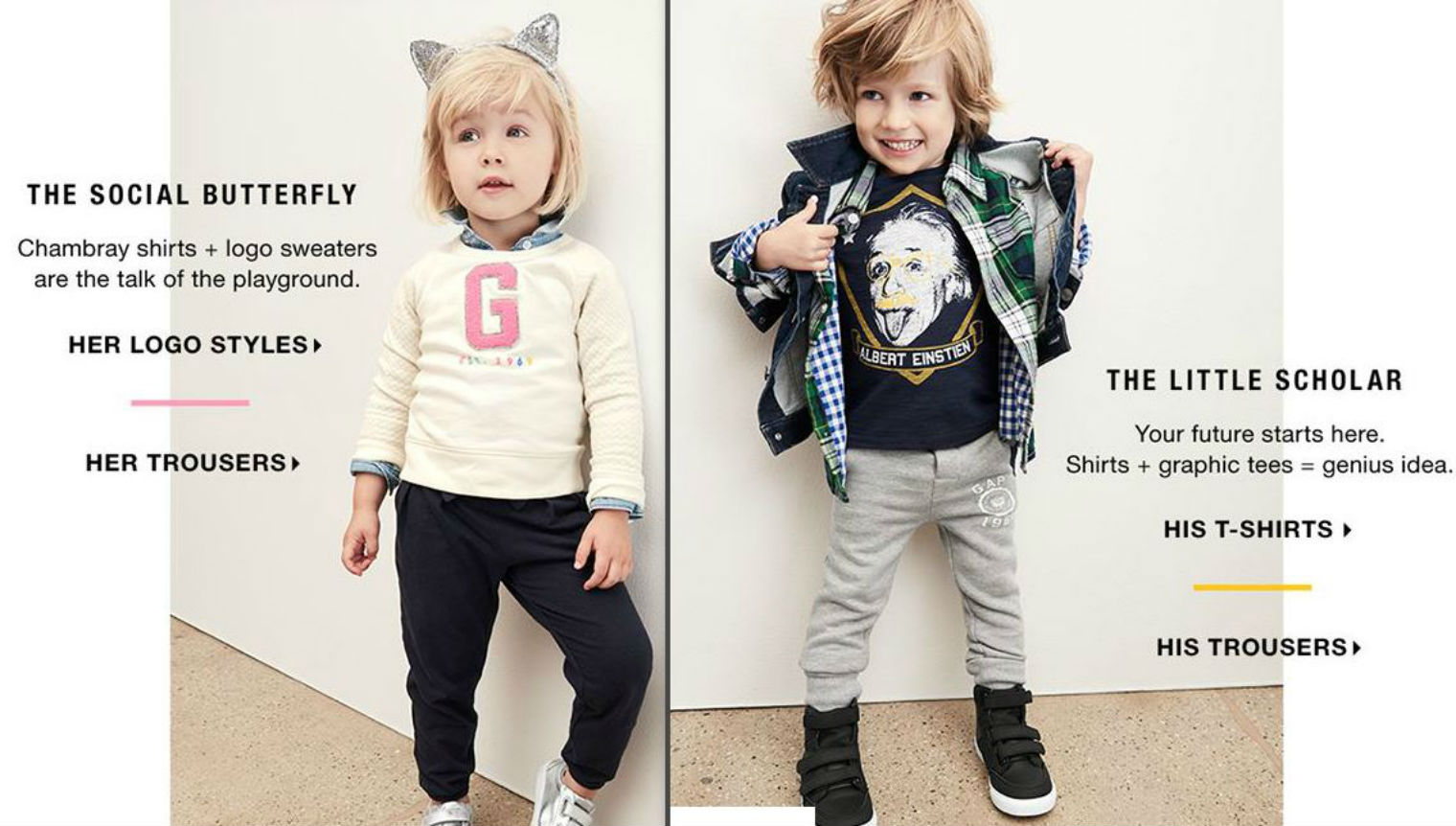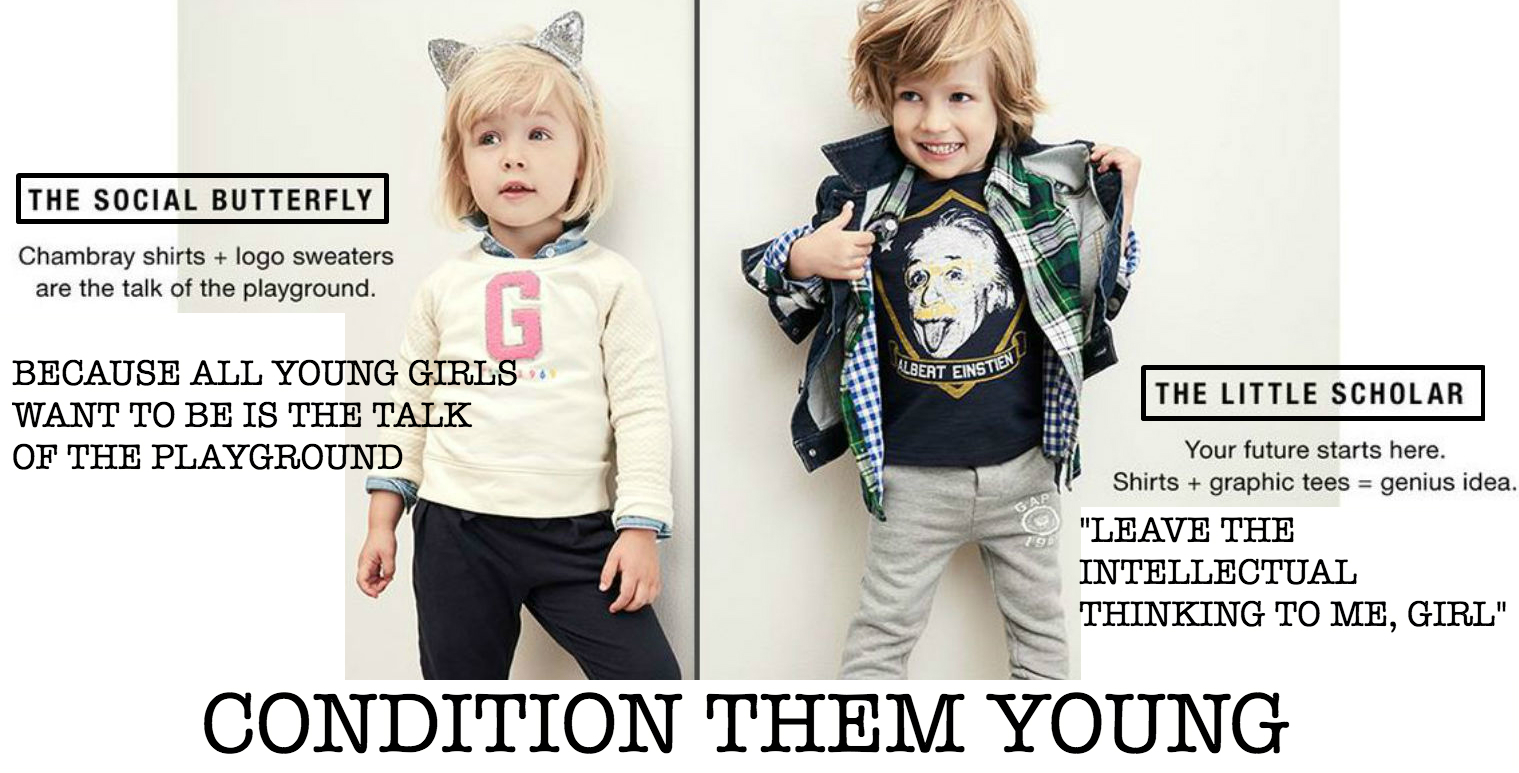Original Advertisement

The impact that mass media and advertising has on young minds has become increasingly substantial. While the messages portrayed may be subliminal, they accumulate to affect the ideologies of new generations. Gap, as a worldwide clothing retailer, has their target demographic set for all members of the family – from infancy into adulthood. In a recent digital ad campaign for their children’s clothing line, they featured two young models with accompanying descriptions or concepts. The young girl is labelled “The Social Butterfly”, whereas the young boy is distinguished as “The Little Scholar” while sporting an Albert Einstein graphic tee. While at first glance this distinction may be harmless, the underlying messages that this may send to young children and their parents remains problematic.
Gender roles are perceived by children at a very young age. As impressionable as they can be, to be exposed to these types of discrepancies in what roles they are “supposed” to take on may affect their aspirations and perceptions of themselves. By portraying these types of gender stereotypes, the interests of many children become limited. Resultantly, to relate the young girl’s clothing items to being, “the talk of the playground” undermines her capabilities and wide range of desires. This is especially highlighted alongside the young boy who is labelled as “The Little Scholar”, in which his “future begins here”. To promote education and learning through their campaign is beneficial, but to create such a blasé contrast between the two genders exposes how sexism is covertly manifested in everyday life.
As men still largely dominate the significant STEM (science, technology, engineering and mathematics) fields, many researchers are left wondering why this is the case. Many gender biases in the industries and work environments remain, but many women also self-exclude themselves from such fields to begin with due to academic and cultural streaming. As with this Gap advertisement, both young models may aspire to become little scholars. Ultimately, while these campaigns may seem harmless at first, the social implications they may end up having is significant and preventable for future generations.
Jammed Version of the Advertisement

In my deconstructed version of the Gap advertisement, I used satirical statements to emphasize the underlying sexist messages of the campaign. Since many harmful denotations within the media may be concealed, exaggerating the extent of what the marketers are implying may help them comprehend the messages they send to consumers. As Mark Dery mentions the common use of “guerrilla semiotics” by culture jammers, I attempted to similarly decode the signs and symbols that “constitute a culture’s secret language” and make evident the hidden meanings within the sign language of a media driven culture.
By stating to “condition them young”, it highlights the reality of the campaign – even at the toddler age level, gender roles have begun to set the stage. Whether the harmful intention was there or not, these types of differentiations form the self-perceptions of new generations. Young girls look up to figures in the media, and to see their interests limited to being “the talk of the playground” may unconsciously affect their thoughts. By emphasizing this through sarcasm, one may take time to consider how nonsensical it is to place such limitations on a young girl’s dynamic personality. Also, is achieving higher education and intellectual thinking a male’s role in society? Are they the source of all genius ideas? If not, then why is such a contrast made in this advertisement? I hoped to provoke these types of questions when adding the thought bubble next to the young boy’s ad description.
To conclude, they have also misspelled Albert Einstein’s name as “Albert Einstien” on the young boy’s graphic tee. This may go to show how little thought was put into planning these clothing lines and campaigns. What may initially seem like a playful and light-hearted campaign can have darker implicit meaning. Ultimately, with more consideration for details, this type of harmful advertising concept could have been avoided. This seems to be the case for many other ad campaigns, which merely focus on marketing their product for a profit with a lack of concern for what messages they send through their images.
Mark Dery’s Summary of Culture Jamming: http://markdery.com/?page_id=154
Recent Comments